Labels for Safety, Visual and Facility ID Desktop Printers
Floor Marking Guide
The benefits of color-coding your floors and pathways
Overview
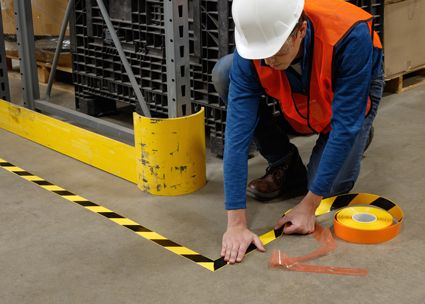
Your shop floor sees a lot of action. It’s where your employees work, where your equipment lives and where your forklifts travel. It supports the constant motion of your workplace, day in and day out. But, the hustle and bustle of your shop floor can create ample opportunity for your employees to be injured.
An effective way to prevent potential injuries is by clearly marking permanent aisles and passageways with floor marking tape, as required by the Occupational Safety and Health Association (OSHA). However, an expanded floor marking system that incorporates Lean / 5S and visual workplace concepts, as well as standardizes color-coding, can improve both safety and efficiency.
Leaner, more efficient operations
A standardized floor marking color system helps employees associate certain colors with certain areas or actions. This helps them quickly and easily move around that facility to complete their tasks and find what they need. A color-coded floor marking system helps to:
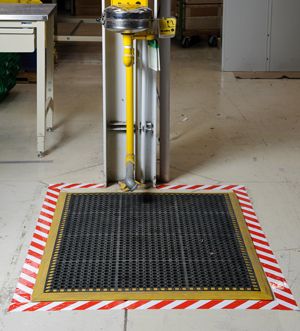
- Emphasize important information. Using floor marking tape to highlight your facility’s aisleways and exit paths clearly identifies the safest path through the facility. This helps keep pedestrians and forklifts safe and provides quick egress guidance in an emergency.
- Keep your facility organized by showing associations. For example, when you mark both a cart and the area the cart should be stored with the same color tape or paint, employees can easily associate when the cart is not in its intended location.
- Provide critical information at the point of need. When hazards are consistently marked with bright colors (red / yellow) it provides critical safety information to employees directly at the point of need where it is more pertinent.
- Increase employee efficiency, because employees spend less time looking for what they need. For example, when trying to locate a certain material storage area, knowing what color floor marking to look for helps you find it faster.
Regulations and industry standards
While several OSHA regulations dictate that permanent aisles and passageways must be clearly marked, there are no current government-mandated or even widely accepted industry standards that recommend what colors to use when marking floors.
However, when it comes to workplace visuals there are a number of relevant standards that require or imply the need for marking and color-coding:
Occupational Safety and Health Administration (OSHA) Floor Marking Guidelines
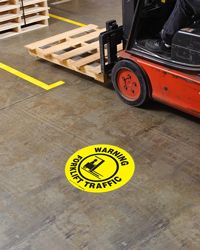
Use of Mechanical Equipment
§1910.176(a) Where mechanical handling equipment is used, sufficient safe clearances shall be allowed for aisles, at loading docks, through doorways and wherever turns or passage must be made. Aisles and passageways shall be kept clear and in good repair, with no obstruction across or in aisles that could create a hazard. Permanent aisles and passageways shall be appropriately marked.
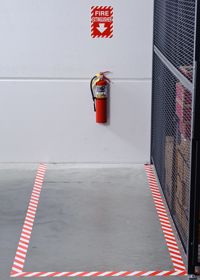
General Environmental Controls
§1910.144 Red shall be the basic color for the identification of fire protection equipment and apparatus, containers of flammable liquids, stop buttons and electrical switches used for emergency stopping of equipment.
§1910.144(a)(1) Red shall be the basic color for the identification of fire protection equipment and apparatus.
§1910.144(a)(3) Yellow shall be the basic color for designating caution and marking physical hazards.
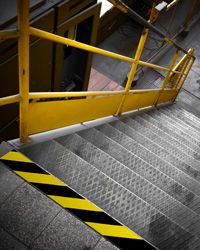
Means of Egress
§1910.35 OSHA will deem an employer demonstrating compliance with the exit route provisions of NFPA 101, Life Safety Code, or the exit-route provisions of the International Fire Code (IFC), 2009 edition, to be in compliance with §1910.34, §1910.36 and §1910.37.
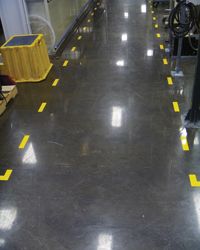
Letter of Interpretation
§1910.22(b) The lines used to delineate aisles may be any color so long as they clearly define the area considered as aisle space. The lines may be composed of dots, square, strip or continuous. The recommended width of aisle markings varies from 2 in. to 6 in., therefore any width 2 in. or more is considered acceptable.
International Fire Code 2009
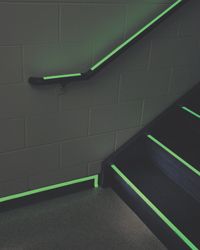
§1024.1 Approved luminous egress path markings delineating the exit path shall be provided...having occupied floors located more than 75 ft. above the lowest level of fire department vehicle access.
§1024.2.1 A solid and continuous stripe shall be applied to the horizontal leading edge of each step and shall extend the full length of each step.
§1024.2.4 Perimeter and floor mounted demarcation lines shall be placed within 4 in. of the wall and extend to within 2 in. of the markings on the leading edge of landings. Demarcation lines shall be 1 in. to 2 in. wide with interruptions not exceeding 4 in.
Additional relevant standards
When it comes to workplace visuals, there are a number of relevant standards that require or imply the need for marking and color-coding:
ANSI color guide — safety signage
Some experts reference the ANSI Z535.1 Safety Color Code standard as a guide for floor marking. While earlier versions of the standard (ANSI Z353.1-1998) did include color specifications for specific types of safety hazards and equipment, these specifications were removed from the 2002 edition of the standard and no longer represent ANSI recommended best practices. Section 4.2 of the standard explicitly states that the specifications are intended for use on safety signage, not for floor marking.
OSHA color guide — hazards
Some experts also reference OSHA standard 29 CFR 1910.144, the Safety Color Code for Marking Physical Hazards. However, these specifications are extremely limited in scope and are not designed to provide guidance on color usage when marking floors either. The standard states that red should be used to identify fire protection equipment, emergency stop devices and containers holding dangerous materials. Yellow should be used for marking physical hazards (such as striking against, stumbling, falling, tripping and caught-in-between hazards).
Floor marking color standards guide
With the right colors in the right places, you can easily keep workers on the right path and identify equipment, storage areas, hazardous areas, forklift traffic and more. Use as few colors as possible to make it easier for employees to remember the meaning of each color and reduce the number of floor marking products you need.
This color guide will help your floor marking be consistent in your workplace:
Yellow
Aisle ways, traffic lanes and work cells.
White
Equipment and fixtures not otherwise color coded (workstations, carts, floor stand displays, racks, etc.)
Blue | Green | Black
Materials and components, including raw materials, work-in-progress and finished goods
Orange
Materials or products held for inspection
Red
Defects, scrap, rework and red tag areas
Photoluminescent
Steps and perimeter demarcation to identify egress routes in a lights-out emergency
Red and White Stripe
Areas to be kept clear for safety/compliance reasons (areas in front of electrical panels, firefighting equipment, and safety equipment)
Black and White Stripe
Areas to be kept clear for operational purposes (not related to safety or compliance standards)
Yellow and Black Stripe
Areas that may expose employees to physical or health hazards